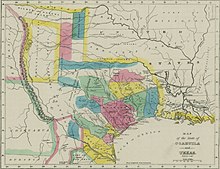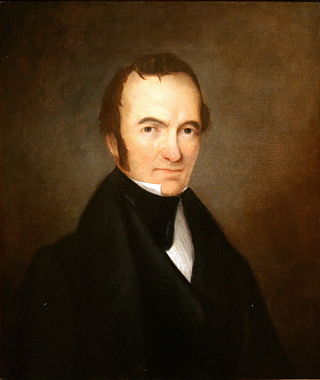
Stephen Fuller Austin was an American-born empresario. Known as the "Father of Texas" and the founder of Anglo Texas, he led the second and, ultimately, the successful colonization of the region by bringing 300 families and their slaves from the United States to the Tejas region of Mexico in 1825.

Falls County is a county in the U.S. state of Texas. As of the 2020 census, its population was 16,968. The county seat is Marlin. It is named for the original 10-foot-tall waterfall on the Brazos River, which existed until the river changed course during a storm in 1866. The present falls is two miles northeast of the original falls, at the Falls on the Brazos Park, a camping site only a few miles out of Marlin on Farm to Market Road 712.

Coryell County is a county located on the Edwards Plateau in the U.S. state of Texas. As of the 2020 census, its population was 83,093. The county seat is Gatesville. The county is named for James Coryell, a frontiersman and Texas Ranger who was killed by Caddo Indians.
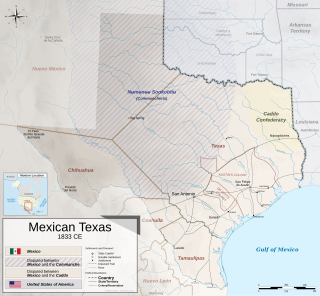
Mexican Texas is the historiographical name used to refer to the era of Texan history between 1821 and 1836, when it was part of Mexico. Mexico gained independence in 1821 after winning its war against Spain, which began in 1810. Initially, Mexican Texas operated similarly to Spanish Texas. Ratification of the 1824 Constitution of Mexico created a federal structure, and the province of Tejas was joined with the province of Coahuila to form the state of Coahuila y Tejas.

An empresario was a person who had been granted the right to settle on land in exchange for recruiting and taking responsibility for settling the eastern areas of Coahuila y Tejas in the early nineteenth century. The word in Spanish for entrepreneur is emprendedor.

Haden Edwards was a Texas settler. Edwards County, Texas on the Edwards Plateau is named for him. In 1825, Edwards received a land grant from the Mexican government, allowing him to settle families in East Texas. His grant included the city of Nacogdoches, and Edwards soon angered many of the previous settlers. After his contract was revoked in 1826, Edwards and his brother declared the colony to be the Republic of Fredonia. He was forced to flee Mexico when the Mexican Army arrived to put down the rebellion, and did not return until after the Texas Revolution had broken out.
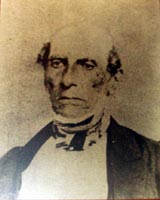
Henri Castro, a Jewish Texan, was one of the most important empresarios of the Republic of Texas.

The "Old Three Hundred" were 297 grantees who purchased 307 parcels of land from Stephen Fuller Austin in Mexican Texas. Each grantee was head of a household, or, in some cases, a partnership of unmarried men. Austin was an American approved in 1822 by Mexico as an empresario for this effort, after the nation had gained independence from Spain. By 1825 the colony had a population of 1,790, including 443 enslaved African Americans. Because the Americans believed they needed enslaved workers, Austin negotiated with the Mexican government to gain approval, as the new nation was opposed to slavery. Mexico abolished it in 1837.
The DeWitt Colony was a settlement in Mexico founded by Green DeWitt. From lands belonging to that colony, the present Texas counties of DeWitt, Guadalupe and Lavaca were created. The hub of the colony was primarily located, however, in what is now Gonzales County. The first battle of the Texas Revolution occurred in the DeWitt Colony.

Green DeWitt was an empresario in Mexican Texas. He brought families from the United States to what is now South-central Texas and founded the DeWitt Colony.
Rafael Antonio Manchola was a politician and military officer in Mexican Texas. He twice served as commandant of Presidio La Bahía. He served two terms in the legislature of the state of Coahuila y Tejas. At his behest, the community which had grown outside the fort was renamed Goliad and elevated in status to a villa. During his legislative service, Manchola also negotiated official boundaries for the colony of his father-in-law, Martín De León, and had a commissioner appointed to grant official titles to the settlers in that colony. After returning home, Manchola became the alcade of Goliad and initiated a resolution–then considered illegal– supporting the Constitution of 1824 and Mexican President Antonio Lopez de Santa Anna. He briefly attended the Convention of 1832 and volunteered to accompany William H. Wharton in journeying to Mexico City to request separate statehood for Texas. The mission was postponed, and Manchola died of cholera in late 1832 or early 1833.
James Power was an Irish-born Texan empresario, politician and signer of the Texas Declaration of Independence, known for the land grant he received with partner James Hewetson that included the coastal area between the mouths of the Guadalupe and Nueces Rivers, as well as his founding and service as the first mayor of the Aransas City settlement. He often represented Refugio County during statewide conventions. Was part of the Mexican national era
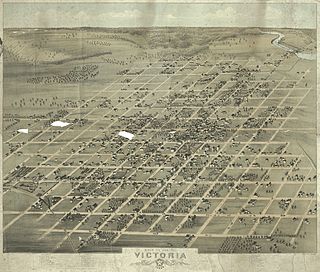
De León's Colony was established in 1824 in the northern Coahuila y Tejas state of the First Mexican Republic, by empresario Martín De León. It was the only ethnically Mexican colony founded during the Mexican period (1824-1835) that is located within the present-day U.S. state of Texas.

Martín De León (1765–1833) was a rancher and wealthy Mexican empresario in Texas who was descended from Spanish aristocracy. He was the patriarch of one of the prominent founding families of early Texas. De León and his wife Patricia de la Garza established De León's Colony, the only predominantly Mexican colony in Texas. They founded the town of Villa de Nuestra Señora de Guadalupe Victoria Nombre de Jesús on the Guadalupe River. The name referred both to the river and to Mexico's president Guadalupe Victoria.

Elijah Sterling Clack Robertson (1820–1879) was an early Euro-American settler in Robertson's Colony in Texas. His father was the colony's founder Sterling C. Robertson. Brought to Texas to learn Spanish, he translated for both Robertson's Colony and later the Texas General Land Office. He practiced law in Milam County. Robertson was a postmaster for the Republic of Texas and the leader of a volunteer group who aided Alexander Somervell in border disputes. By 1844, he had been promoted to colonel in the Republic of Texas militia. Robertson was one of the delegates who signed the Texas Order of Secession in 1861 and served as aide-de-camp to General Henry McCulloch. The Col. Elijah Sterling Clack Robertson Plantation in Salado is listed on the National Register of Historic Places listings in Bell County, Texas.
Sterling Clack Robertson (1785–1842) was an empresario from Tennessee, during Mexican Texas. He introduced 600 families into Robertson's Colony. Robertson was also an elected delegate to the Washington-on-the-Brazos convention, signing both the Texas Declaration of Independence and the Constitution of the Republic of Texas. He became a senator during the first two sessions of the Congress of the Republic of Texas.
Sarahville de Viesca or Fort Milam or Bucksnort is a ghost town in Falls County, Texas, United States. The settlement was established in 1834 by Sterling C. Robertson and named for his mother Mrs. Sarah Robertson and Agustín Viesca, the Mexican governor of Coahuila y Tejas. The site was located at the falls of the Brazos River, where the river formerly dropped 10 feet (3 m) and where a well-used ford was located. The town was temporarily deserted in 1836 during the Runaway Scrape and permanently abandoned soon afterward because of native American raids. Fort Milam was built on the west-bank site but abandoned a few years later in favor of the town of Bucksnort, which occupied the east bank. Bucksnort vanished when the nearby town of Marlin was founded. There is a county park and historical marker located where Farm to Market Road 712 crosses the Brazos, south of Marlin.

The Lake Creek Settlement was a settlement in Stephen F. Austin's Second Colony, located in Mexican Texas, and later the Republic of Texas after it gained independence in 1836. The Lake Creek Settlement was located between the West Fork of the San Jacinto River (Texas) and the stream known as Lake Creek. It was the first Anglo-American settlement in what is today western Montgomery County, Texas.
Peters Colony is a name applied to four empresario land grant contracts first by the Republic of Texas and then the State of Texas for settlement in North Texas. The contracts were signed by groups of American and English investors originally headed by William Smalling Peters. Samuel Browning, Peters' son-in-law signed the first contract with the Republic of Texas in Austin on August 30, 1841. Ownership of the empresario company changed many times during the life of the contracts.
Santiago del Valle was a Mexican hacendado and government official for Coahuila y Tejas during the Texas Revolution. Del Valle obtained a land grant from the Mexican government, which led to the founding of Galveston, Texas and several towns in Travis County, including Del Valle, which is named in his honor. In 1825, he served as president of the Congreso Constituyente of the state of Coahuila y Tejas, counselor to governor Victor Blanco, and as the arbitrator in a feud between the Sánchez Navarro and Elizondo families.
